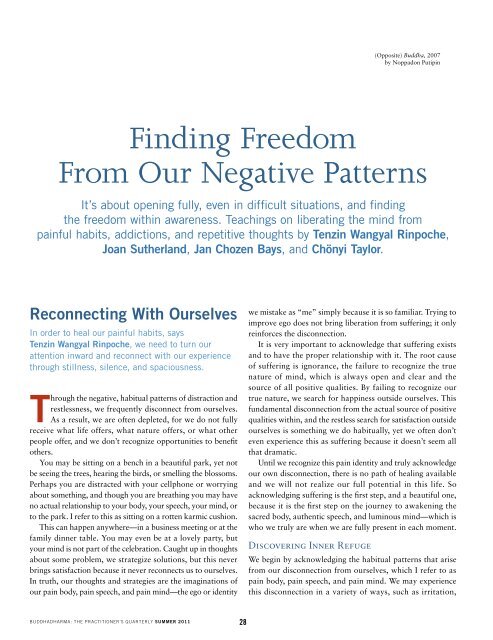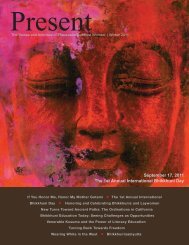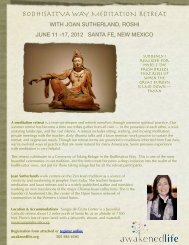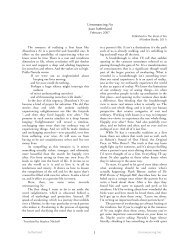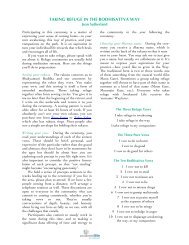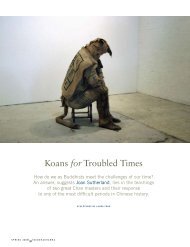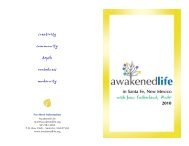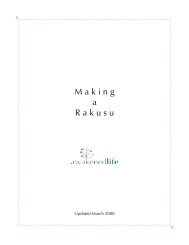Gaining Perspective - Awakened Life
Gaining Perspective - Awakened Life
Gaining Perspective - Awakened Life
- No tags were found...
Create successful ePaper yourself
Turn your PDF publications into a flip-book with our unique Google optimized e-Paper software.
(Opposite) Buddha, 2007by Noppadon PutipinFinding FreedomFrom Our Negative PatternsIt’s about opening fully, even in difficult situations, and findingthe freedom within awareness. Teachings on liberating the mind frompainful habits, addictions, and repetitive thoughts by Tenzin Wangyal Rinpoche,Joan Sutherland, Jan Chozen Bays, and Chönyi Taylor.Reconnecting With OurselvesIn order to heal our painful habits, saysTenzin Wangyal Rinpoche, we need to turn ourattention inward and reconnect with our experiencethrough stillness, silence, and spaciousness.Through the negative, habitual patterns of distraction andrestlessness, we frequently disconnect from ourselves.As a result, we are often depleted, for we do not fullyreceive what life offers, what nature offers, or what otherpeople offer, and we don’t recognize opportunities to benefitothers.You may be sitting on a bench in a beautiful park, yet notbe seeing the trees, hearing the birds, or smelling the blossoms.Perhaps you are distracted with your cellphone or worryingabout something, and though you are breathing you may haveno actual relationship to your body, your speech, your mind, orto the park. I refer to this as sitting on a rotten karmic cushion.This can happen anywhere—in a business meeting or at thefamily dinner table. You may even be at a lovely party, butyour mind is not part of the celebration. Caught up in thoughtsabout some problem, we strategize solutions, but this neverbrings satisfaction because it never reconnects us to ourselves.In truth, our thoughts and strategies are the imaginations ofour pain body, pain speech, and pain mind—the ego or identitywe mistake as “me” simply because it is so familiar. Trying toimprove ego does not bring liberation from suffering; it onlyreinforces the disconnection.It is very important to acknowledge that suffering existsand to have the proper relationship with it. The root causeof suffering is ignorance, the failure to recognize the truenature of mind, which is always open and clear and thesource of all positive qualities. By failing to recognize ourtrue nature, we search for happiness outside ourselves. Thisfundamental disconnection from the actual source of positivequalities within, and the restless search for satisfaction outsideourselves is something we do habitually, yet we often don’teven experience this as suffering because it doesn’t seem allthat dramatic.Until we recognize this pain identity and truly acknowledgeour own disconnection, there is no path of healing availableand we will not realize our full potential in this life. Soacknowledging suffering is the first step, and a beautiful one,because it is the first step on the journey to awakening thesacred body, authentic speech, and luminous mind—which iswho we truly are when we are fully present in each moment.Discovering Inner RefugeWe begin by acknowledging the habitual patterns that arisefrom our disconnection from ourselves, which I refer to aspain body, pain speech, and pain mind. We may experiencethis disconnection in a variety of ways, such as irritation,buddhadharma: the practitioner’s quarterly summer 2011 28
(Opposite)Untitled, 2008by Cathy Daley<strong>Gaining</strong> <strong>Perspective</strong>When you’re caught in your habitual patterns, saysJoan Sutherland, try not to fixate on your reactions.Instead cultivate awareness of everything that ishappening in the moment.Sometimes it can seem as though being human is a problemthat spiritual practice is meant to solve. But Buddhistmeditative and related practices actually have adifferent focus: developing our human faculties to see moreclearly the true nature of things, so that we can participate inand respond to how things are in a more generous and helpfulway. Our individual awakenings become part of the world’sawakening. This means leaning into life, and to do that wehave to recognize what gets in the way. For each of us, thisis likely to include certain habitual patterns of thinking andfeeling in reaction to what we encounter.Meditation and inquiry are methods, ways to have directexperiences of the deepest insights of our tradition—of theinterpermeation of all things and the way things, including ourhabitual reactions, rise into existence for awhile and then fallaway again. Everything is provisional, and everything influenceseverything else. The implication for our inner lives isthat they are seamless with the outer world, and constantlychanging with it. We’re not encapsulated consciousnessesbouncing around in a world of other consciousnesses and inertmatter, but part of a vibrant, ever-changing field that encompasseseverything we can experience, and more. Everything isrising and falling in this field, sometimes for a nanosecond andsometimes for a geological age, but still appearing and disappearingin an infinitely complex webof other things doing the same. To theextent that we experience, in the ordinarymoments of our lives, the seamlessnessof our inner states and outerJoan Sutherland, Roshi is a Zen koan teacher andthe founder of <strong>Awakened</strong> <strong>Life</strong> in Santa Fe, NewMexico.circumstances, we’re being more realistic, more in tune withthe way things actually are.From this perspective, how do we deal with the habitualpatterns of heart and mind that inhibit us from having a morerealistic understanding of life, and a more intimate engagementwith it? Perhaps it becomes less important to tackle thethoughts and feelings directly, to do something about them,than it is to see them in their true proportion. A reaction,after all, is just one thing among many appearing in the fieldat that particular moment, no more or less important thananything else.Simply put, how we react is not the most important elementof any situation. When we fixate on our reactions, theypull us away from a primary experience of what’s actuallyhappening, into a small room where how we think and feelabout the experience becomes the most important thing, thething we’re now in relationship with. If you and I are having aconversation and I become angry, I might find my emotions socompelling that suddenly I’m not in a conversation with youanymore, but with my anger. What’s wrong with this person?This must not stand! Then, particularly if I’m involved in aspiritual practice, I’m likely to have reactions to my reactions.After all this meditation, I shouldn’t be getting angry like this!Or, This is righteous anger! Now I’m in the third order ofexperience, moving further and further away from the actualconversation with you.If we pull the camera back for a wider view, it’s immediatelyapparent that a reaction like this is only one of manythings rising in any given moment in the field. There’s youand me and our surroundings, your mood, my capacity formisunderstanding, the temperature of the air, the sound ofbirds or traffic outside the window and the neighborhoodbeyond that, the most recent calamity in the news, and moreother phenomena than we can possibly take into account.The moment is vast, with a lot of space between the thingsin it. The moment is generous. I don’t have to zero in on myreaction, to act impulsively on it or repudiate it or improve it,all of which tend to reinforce the sense of its importance, butjust accept it as one (small) part of what’s happening. Usuallythat simple shift changes everything. It allows us to step outof the small room of second-order experience and back intoa fuller, more realistic experience of the moment.Margo Conoverbuddhadharma: the practitioner’s quarterly summer 2011 32
Getting to Know Your Inner CriticJan Chozen Bays explains how to recognize and tame the critical commentarywe replay in our minds.Once when the Buddha was injured by an enemy, hespent hours meditating on the physical sensations ofpain, without giving in to mental or emotional distress.Finally he lay down to rest. Mara the Evil One appeared andberated him. “Why are you lying down? Are you in a dazeor drunk? Don’t you have any goals to accomplish?” TheBuddha recognized Mara and said, “I’m not drunk or in adaze. I’ve reached the goal and am free of sorrow. I lie downfull of compassion for living beings.” Then Mara, sad anddisappointed, disappeared.In this story Mara is depicted as an external entity. However,I have found that the most insidious obstacle actually arisesfrom within. It is called the Inner Critic. If left unrecognizedand unchecked, it creates a pattern of negative inner commentsthat can undermine our well-being and destroy our creativity,attacking our work when we’ve written just a few sentences,sung just a few notes, or painted only few strokes. Even worse,it can destroy our spiritual practice.The Inner Critic criticizes whatever is in front of it. Forexample, if you don’t go to a meditation retreat, it says, “Youaren’t very serious about your practice.” If you do go to theretreat it says, “You wasted so much time daydreaming duringthat retreat, you should have stayed home.” A hallmark of theInner Critic is that it often puts us in a double bind, damnedif we practice and damned if we don’t.How can we work with the Inner Critic? The story of theBuddha gives us some clues. Just as the Buddha recognizedMara, we need to recognize the Inner Critic not as the truth,but as a single voice among many. You can even give it aname. “Oh, hi there Mr. Negativity. What are you so workedup about now?”For the Inner Critic does indeed get worked up. It arises© vivienne flesherbuddhadharma: the practitioner’s quarterly summer 2011 34
(Opposite)Untitled, 2005by Vivienne Flesherjennifer brinkmanin childhood, trying to keep us from getting into trouble. Itreviews our mistakes endlessly, in an attempt to prevent futureerrors or failures. It believes that the best way to ensure ourhappiness is to berate us about our shortcomings. It doesn’trealize that it is also stealing our innate capacity for happiness.As we grow older, it can infiltrate our mind so thoroughly thatwe don’t realize that we have fallen into a pervasively negativepattern of thinking aboutourselves. When this happens,people begin to think ofthemselves as “defective” or‘broken.”I point out to students thatthey would never rent andwatch the same painful movie two hundred and fifty times.And yet they allow their mind to play painful episodes fromthe past over and over. “Remember when you made that stupidmistake? Let’s run that mind movie again, and again, andagain.” We need to tell the Inner Critic that we aren’t stupid.We only need to review our past mistakes once or twice, thenmove on with determination to change.It helps to get some perspective on the damage a strongInner Critic can do. Imagine that you heard a mother in asupermarket saying out loud to her three-year-old child whatyour Inner Critic says to you. “You’re an idiot! I’ve told youa million times not to do that. You’re hopeless!” We wouldall recognize these statements as harmful, or even abusive. Noone, a child, a pet, or a plant, can thrive under that pattern ofnegative attack. And yet we allow our Inner Critic to attackus in this way, repeatedly.The Buddha was quite clearabout not giving energy toafflictive thoughts. He divided allhis thoughts into two classes, thosethat led to enlightenment and thoseJust as the Buddha recognized Mara,we need to recognize the Inner Criticnot as the truth but as a single voiceamong many.Jan Chozen Bays is co-abbot of Great VowZen Monastery in Clatskanie, Oregon, whereshe leads workshops on transforming theInner Critic. Her forthcoming book is How toTrain a Wild Elephant & Other Adventures inMindfulness (Shambhala Publications, July).that led away. He cultivated the former and put aside the latter.If you recognize the Inner Critic and stop feeding it mentalenergy, its power will weaken.How can we cultivate a voice to subdue the Inner Critic?Through metta, loving-kindness practice. We can meditate asthe Buddha did, full of compassion for living beings—includingourselves. We can breathe out the silent phrases, “May I be freefrom anxiety and fear. MayI be at ease.” We can evendirect these phrases towardthe Inner Critic, because thisis the very part of us thatis chronically anxious andfearful. It is desperately afraidthat we will make a mistake, lose our job, be unloved, becomehomeless, grow old, become ill and die—which of course,eventually, we will.Indeed, there is often a kernel of truth in what the InnerCritic says. Yes, I was drowsy during that last meditationperiod. However, that does not mean that I am bad, stupid, orhopeless. It just means that I had a sleepy period. Now I willdrop the past and do my best during the next period. Whenwe can hear what the Critic says and take away the anger,the sting, the invidious comparisons of self and other, then itis transformed into the voice of discriminating wisdom anddetermination.Ultimately, the only sure cure for the Inner Critic is topractice. The Critic relies upon an idea of a self—a small self—that is imperfect and must be fixed. It feeds on comparing, onthoughts of past and future, of mistakes and anxieties. TheInner Critic has no traction in the present moment. When ourminds become quiet, when we are resting in this very moment,there is no past or future, there is no comparing. The small selfexpands to become a huge field of calm awareness in whichsensations, thoughts, and voices come and go. Everything isjust as it is, perfect in its own place, interconnected with everyother piece of the whole. Every being also is perfect as it is,including the temporary collection of energy we call our self.Every morning at the monastery we remind ourselves ofthis truth as we chant, “buddhanature pervades the wholeuniverse, existing right here now.” In us, as us. Nothing isbroken.35summer 2011 buddhadharma: the practitioner’s quarterly
On Your Mark,Get Set… Don’t GoChönyi Taylor presents a meditation tofamiliarize yourself with the triggersthat set off addictive behaviors.The triggers for our addictions are thosethings or thoughts that set off anautomatic reaction in such a way that wefind ourselves in our addictive pattern withoutknowing how we got there.The triggers might be external, or internal,or both. An external event such as a song canset off an internal trigger such as loneliness. Wemay not be aware of hearing the song, just thatthe feeling of loneliness has welled up againand we want to escape from it. We may notbe aware of the loneliness, just the thoughtof wanting to fix some dissatisfaction. Wemay not be aware of the dissatisfaction, justof taking or doing whatever will ease it. Wemay not even be aware of what we’re doing,but then suddenly realize we are back in thegrip of addiction.If we can identify the trigger, we can disarmits effect and no longer be caught in thatparticular compulsion. To find what triggersour addiction, we need to sit and contemplate.As we identify the immediate triggers, we oftenfind other, more subtle ones. Sometimes whenpeople discover another trigger, they feel thatwhat they did before was wrong or a wasteof time. Don’t get caught in that trap. Anyaddiction usually has more than one trigger.Meditation forFinding TriggersThis meditation focuses on what happenedjust before you indulged in your addiction sothat you can identify the immediate trigger.Begin by thinking about how your addictionhas harmed you or others, and how you wouldbuddhadharma: the practitioner’s quarterly summer 2011 36
(Opposite)Untitled, 2007by Cathy DaleyAs you become aware of the moments before you fall intoyour addictive pattern, you gain more power to protect yourself fromthe compulsiveness of that pattern.like to stop creating harm in this way. Generate the motivationto first clear obstacles from your mind that stop you fromthinking clearly and then to fill your mind with love andwisdom. Tune in to the energy of pure compassionate wisdom,feeling that you are being nurtured by this energy.Slow your mind down by being aware of your breathingfor a few minutes. Now bring to mind a recent time when youindulged in your addiction and focus on the moment whenyou started. Go back a fraction of time to when you were justabout to engage in your addiction. Meditate on that moment.External TriggersTry to build up a vivid awareness of your surroundings at thattime. Imagine this past event as a present experience. Whereare you? Are there people around or are you alone? What canyou see? What smells are there? What taste is in your mouthand what sounds can you hear? Is your body aching, or numb?Are you comfortable or uncomfortable? Any of these thingsmight be an external trigger. View the trigger with equanimity.Stay with your awareness of this for as long as you can.Internal TriggersContinue by building up a vivid awareness of what washappening in your mind at that time. Did you have anypain? Were you stressed? Were you winding down? Were youwinding up? Had you just hada fight? Were you lonely? Hadsomeone disappointed you orChönyi Taylor was ordained as aBuddhist nun by the Dalai Lama in1996. She is a retired psychotherapistand honorary lecturer in psychologicalmedicine at Sydney University. Thisteaching is adapted from her bookEnough! A Buddhist Approachto Finding Release from AddictivePatterns, published by Snow Lion.had you disappointed yourself? Was there someone or somepeople you were trying to impress? Did you feel cheated bylife? Were you unable to cope? What else?Any of these might be internal triggers. View them withequanimity. Stay with your awareness of that moment as longand as vividly as you can. Know clearly those aspects of themoment that were triggers setting you off into the addiction.Acknowledge to yourself that this is your reality, and addictionis, or has been, the way in which you cope with your reality.Closing the MeditationAllow yourself to abide in the energy of pure compassionatewisdom. Imagine this energy being absorbed into your bodyand healing all hurt and pain and sickness. Allow your body tofeel relaxed, at ease. Imagine this energy of pure compassionatewisdom being absorbed into every part of your mind, healingall negative emotions and leaving your mind peaceful andcalm. Rest in that state as long as you can.DedicationTake pleasure in what you have achieved in this meditation,even if parts of what you remembered were painful. Makea conscious choice to use the energy that comes from thispleasure to continue making positive changes to your life.Further Work on Finding TriggersThis meditation needs to be repeated often if you want toget a better feeling for the addiction triggers. As you becomemore aware of the moments before you fall into your addictivepattern, you can more easily change the pattern. As you repeatthe meditation, take it back to just before the moment thatpreceded the addictive behavior, then a fraction earlier thanthat, then a fraction earlier still, and so on. As you do this, yougain more power to protect yourself from the compulsivenessof an addictive pattern. You can keep uncovering levels ofdissatisfaction and pain. Having done that, you can start tofind other ways of dealing with dissatisfaction and pain.37summer 2011 buddhadharma: the practitioner’s quarterly


